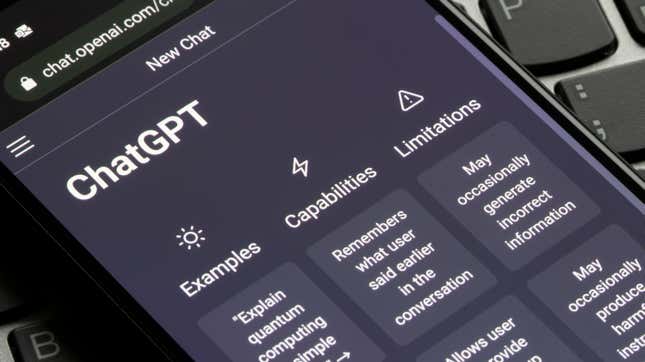ChatGPT’s Website Traffic Dipped for the First Time Since Its Launch
It appears that the artificial intelligence fatigue is upon us: OpenAI’s website traffic has fallen for the first time since the company launched the viral chatbot ChatGPT in November.
Web analytics firm SimilarWeb reported this week that worldwide traffic to OpenAI’s ChatGPT webpage, including both desktop and mobile traffic, dipped 9.7 percent in June. In the U.S. alone, the traffic drop is estimated to be 10.3 percent. at the same time, worldwide unique visitors to the ChatGPT website fell 5.7 percent. SimilarWeb also says that the time people spent on the webpage also dropped 8.5 percent. This reportedly marks the first time traffic has fallen since OpenAI launched ChatGPT eight months ago.
“Whether OpenAI management is brokenhearted about the dip in traffic is debatable. Initially launched as a technology demo, the ChatGPT website primarily serves as a loss leader generating sales leads for OpenAI, which makes its technology available for other companies to embed in their applications,” Similar Web senior insights manager David Carr wrote in the company’s report. “Still, the drop in interest not only for ChatGPT but one of its key competitors is a sign that the novelty has worn off for AI chat. Chatbots will have to prove their worth, rather than taking it for granted, from here on out.”
OpenAI did not immediately return Gizmodo’s request for comment on the reduced traffic.
The trend is not without its precedent, however, as SimilarWeb said in May that traffic to the ChatGPT webpage began to plateau, indicating that June’s drop is likely not just a fluke. Bank of America has also found that it’s not just website visits that are dropping. CNBC reports that downloads for both the ChatGPT and Microsoft Bing apps are down 38% from May to June, according to Bank of America analysts citing data from Sensor Tower.
ChatGPT’s fickle website traffic could be a sign that the widespread allure of the chatbot could be dying down, and while the chatbot quickly rose to prominence over the past few months, it has not been without its issues. A recent study by researchers from the University of California Irvine and the University of Texas Arlington found that training ChatGPT’s GPT3 required 185,000 gallons, or 700,000 liters, of water—a titanic waste that amounts to an average user dumping a large bottle of water on the ground with every conversation. While it depends on copious amounts of water to function, ChatGPT also depends on human laborers, who may be getting stiffed in their paychecks. U.S.-based human contractors, who partake in data labeling to help train the chatbot, make only $15 per hour.

It appears that the artificial intelligence fatigue is upon us: OpenAI’s website traffic has fallen for the first time since the company launched the viral chatbot ChatGPT in November.
Web analytics firm SimilarWeb reported this week that worldwide traffic to OpenAI’s ChatGPT webpage, including both desktop and mobile traffic, dipped 9.7 percent in June. In the U.S. alone, the traffic drop is estimated to be 10.3 percent. at the same time, worldwide unique visitors to the ChatGPT website fell 5.7 percent. SimilarWeb also says that the time people spent on the webpage also dropped 8.5 percent. This reportedly marks the first time traffic has fallen since OpenAI launched ChatGPT eight months ago.
“Whether OpenAI management is brokenhearted about the dip in traffic is debatable. Initially launched as a technology demo, the ChatGPT website primarily serves as a loss leader generating sales leads for OpenAI, which makes its technology available for other companies to embed in their applications,” Similar Web senior insights manager David Carr wrote in the company’s report. “Still, the drop in interest not only for ChatGPT but one of its key competitors is a sign that the novelty has worn off for AI chat. Chatbots will have to prove their worth, rather than taking it for granted, from here on out.”
OpenAI did not immediately return Gizmodo’s request for comment on the reduced traffic.
The trend is not without its precedent, however, as SimilarWeb said in May that traffic to the ChatGPT webpage began to plateau, indicating that June’s drop is likely not just a fluke. Bank of America has also found that it’s not just website visits that are dropping. CNBC reports that downloads for both the ChatGPT and Microsoft Bing apps are down 38% from May to June, according to Bank of America analysts citing data from Sensor Tower.
ChatGPT’s fickle website traffic could be a sign that the widespread allure of the chatbot could be dying down, and while the chatbot quickly rose to prominence over the past few months, it has not been without its issues. A recent study by researchers from the University of California Irvine and the University of Texas Arlington found that training ChatGPT’s GPT3 required 185,000 gallons, or 700,000 liters, of water—a titanic waste that amounts to an average user dumping a large bottle of water on the ground with every conversation. While it depends on copious amounts of water to function, ChatGPT also depends on human laborers, who may be getting stiffed in their paychecks. U.S.-based human contractors, who partake in data labeling to help train the chatbot, make only $15 per hour.
